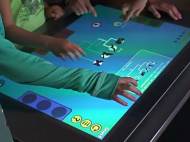Multi-touch table educational games improve learning
 An interdisciplinary team consisting out of computer scientists, biologists, and cognitive psychologists at Harvard, Northwestern, Wellesley, and Tufts, conducted a pair of studies where they investigated the actual learning outcomes of educational games in both formal and informal settings. The results revealed that educational games succeeded at making the process of learning difficult material engaging and collaborative.
An interdisciplinary team consisting out of computer scientists, biologists, and cognitive psychologists at Harvard, Northwestern, Wellesley, and Tufts, conducted a pair of studies where they investigated the actual learning outcomes of educational games in both formal and informal settings. The results revealed that educational games succeeded at making the process of learning difficult material engaging and collaborative.
The users were tested by playing a game on a tabletop multi-user touch-screen which allows simultaneous use by several users who can cooperate or independently work on a single project. The table accommodates multiple users and can also interact with markers (physical objects like cards or blocks) that are placed onto its surface. Two collaborative educational games, named Phylo-Genie and Build-a-Tree, were tested on pairs of college students as well as on families in a busy museum environment.
The Phylo-Genie game, developed by researchers at Harvard, Wellesley, and Tufts, leads students through a scenario in which they have been bitten by an unusual species of snake and must identify its closest relatives in order to choose the correct anti-venom. It was tested on pairs of undergraduate students who had not yet taken a course in evolutionary biology. For comparison, other pairs of students were given the same task in a pen-and-paper format.
Both games were designed and evaluated in accordance with accepted principles of cognitive psychology and learning sciences. In comparison to the paper version, the electronic game produced statistically significantly higher scores on a post-test (an exam borrowed from a Harvard course), as well as higher participant ratings for engagement and collaboration.
The Build-a-Tree game was designed with an informal museum environment in mind. The game asks requires from the users to construct phylogenetic trees by arranging icons toward in the correct order. As the user progresses through several levels, the problems become more challenging.
“Natural history museums have always been a place where the exhibits are behind glass in the gallery”, said Chia Shen, a Senior Research Fellow in Computer Science at the Harvard School of Engineering and Applied Sciences (SEAS) and Director of the Scientists’ Discovery Room Lab. “You come here to see things that you just don’t see anywhere else – fossils millions of years old – and you come here to learn. You see school groups and parents coming in with a serious mind, and we’re breaking into that culture.”
Researchers on this project, directed by lead author Michael S. Horn at Northwestern University and Shen at Harvard, observed 80 families and other social groups interacting with the Build-a-Tree game at the Harvard Museum of Natural History. The results have shown that game performed well, since it allowed the users investigate information independently and to interact with it in an open-ended manner instead guiding the user toward a particular set of facts – thus enabling active prolonged engagement and social learning.
“Evolution is a process that takes millions of years, whereas in chemistry or physics there are all sorts of phenomena that you can experiment with, like the tornado exhibit where you can go in and interrupt the air”, said Shen. “This is our experiment: can we build something that is not as phenomenon-driven but can still engage them? I think we’ve succeeded in that.”
For more information read, the papers published in the Proceedings of the 2012 ACM annual conference on Human Factors in Computing Systems: “Of BATs and APEs: an interactive tabletop game for natural history museums” and “Phylo-Genie: engaging students in collaborative ‘tree-thinking’ through tabletop techniques”.









This is great! I’m a big fan of edutainment in general. Big kudos to people involved into this project. Keep it up!
author
I agree, learning should be fun and conducted through different sensory stimulants, thus making us memorize it in several ways.